Espresso
The Darkness Defined in Espresso Roast
Savor the intense flavors and rich complexity of darkness in espresso roast, a bold and robust experience waiting to be explored.

In espresso roast, darkness signifies a deep intensity of flavors from extended roasting. The process enhances caramelization, smokiness, and richness, contributing to a bold and robust profile perfect for espresso shots. The dark color and oils extracted during roasting create a unique depth and complexity, setting this roast apart. Embrace the harmonious blend of bitter richness and sweet undertones that characterize the darkness in espresso roast. Further exploration reveals a world of robust and diverse flavors waiting to be discovered.
Key Takeaways
- Dark espresso roast features a longer roasting process for rich flavors.
- Characterized by bold and robust taste with caramel, chocolate, and nutty notes.
- High in intensity, bitterness balanced with richness, and low acidity.
- Oils from extended roasting contribute to a dark color and intense flavor.
- Caramelization during roasting enhances smoky and bold taste profile.
Characteristics of Espresso Roast
Espresso roast, tailored specifically for creating intense espresso shots, is characterized by a medium to dark roast level that enhances richness, sweetness, and acidity in the coffee. This particular roast is ideal for extracting the concentrated flavors needed in espresso-based drinks.
The dark roast of espresso beans contributes to a flavor profile that includes a chocolatey body with subtle notes of red berry sweetness, providing a well-rounded taste experience. When brewed under high pressure in espresso machines, the finely ground espresso roast reveals its full potential, resulting in a robust and flavorful shot of espresso.
The balance achieved in espresso roast between richness, sweetness, and acidity guarantees that the flavors remain prominent even when mixed with other ingredients in popular espresso-based beverages like lattes or cappuccinos. Understanding the characteristics of espresso roast is essential for coffee enthusiasts looking to appreciate the nuances of a well-crafted espresso shot.
Flavor Profile of Dark Roasts

Dark roasts boast a bold and robust flavor profile, characterized by a balance of bitterness and richness.
These roasts often feature notes of caramel, chocolate, and nuttiness, creating a deep and intense taste experience.
The extended roasting process at high temperatures leads to the development of a darker color and oils on the surface, enhancing the complex flavors of dark roasts.
Bold and Robust Flavors
Within dark roasts, the bold and robust flavors stand out prominently, offering a distinctive taste experience that captivates coffee enthusiasts.
Dark roasts, characterized by their intense profile, are known for their bold flavors that are perfect for espresso shots. These roasts are roasted at higher temperatures for a longer duration, resulting in a darker color and oils that contribute to their rich taste.
One of the key processes that occurs during the longer roasting of dark roasts is caramelization, where sugars in the beans caramelize, adding depth and complexity to the flavor profile.
Common tasting notes found in dark roasts include caramel, chocolate, and nutty flavors, enhancing the overall richness of the brew.
Due to their robust and balanced flavors, dark roasts are favored for espresso, providing a satisfying and full-bodied coffee experience that many coffee lovers seek.
Bitterness Balanced With Richness
When roasting coffee beans to create dark roasts, the bitterness is carefully balanced with richness to achieve a distinctive flavor profile. Dark roasted coffee offers a bold and smoky taste, characterized by low acidity and hints of caramel, chocolate, and nuts. The art of dark roasting lies in the process of caramelization, where sugars in the beans are transformed, enhancing the depth of flavor. This caramelization not only brings out sweetness but also helps in balancing the inherent bitterness of dark roasts.
To further understand the interplay between bitterness and richness in dark roasted coffee, let's explore the following table:
| Aspect | Description |
|---|---|
| Bitterness | Initial sharp taste that mellows out, providing a robust undertone to the overall flavor profile. |
| Richness | Deep, full-bodied sensation on the palate, often accompanied by notes of caramel and chocolate. |
| Caramelization | Process that intensifies sweetness while adding complexity, contributing to the richness. |
| Flavor Profile | Smoky, bold, and well-rounded with a satisfying mix of caramel, chocolate, and nutty notes. |
Dark roasts, known for their intensity and versatility, are favored in espresso brewing for the rich and fulfilling coffee experience they deliver.
Roasting Process for Dark Espresso

When roasting dark espresso beans, the process involves longer times at high temperatures to achieve a deep, rich flavor.
This extended roasting leads to the extraction of oils on the beans' surface, enhancing the aroma and intensity of the coffee.
The result is an espresso with an intense flavor profile and a robust, smoky taste that sets it apart from lighter roasts.
Intense Flavor Development
To achieve intense flavor development in dark espresso roasts, the roasting process involves subjecting the beans to high temperatures for an extended duration. This extended roasting time results in a darker color of the beans and the formation of oils on the surface, enhancing the richness of the coffee. The caramelization of sugars during this process contributes greatly to the bold and smoky flavor profile characteristic of dark espresso roasts. These intense flavors are what make dark espresso roasts ideal for the espresso brewing method, as they create concentrated and balanced espresso shots. The lower acidity levels in dark espresso roasts also add to their appeal, providing a robust and full-bodied coffee experience. Below is a table summarizing the key points related to the intense flavor development in dark espresso roast:
| Aspect | Description |
|---|---|
| Roasting Temperature | High temperatures are applied for an extended duration to develop intense flavors. |
| Oil Formation | Extended roasting leads to oils on the beans, enhancing richness. |
| Flavor Profile | Caramelization of sugars contributes to bold and smoky flavors. |
| Ideal for Espresso | Dark roasts create balanced espresso shots with concentrated flavors. |
Rich Aroma Extraction
During the roasting process for dark espresso, the extraction of rich aromas is an indispensable aspect that enhances the overall coffee experience.
Dark espresso roast involves subjecting the beans to high temperatures for an extended period, leading to the development of oils on the surface of the beans. These oily beans contribute to a fuller body and a more pronounced aroma in the final cup of espresso.
The roasting process for dark espresso roast is pivotal in achieving a bolder and more intense flavor profile. As the beans reach a darker color during roasting, the caramelization of sugars within them imparts robust and smoky notes to the coffee.
This richness in aroma extraction is what sets dark espresso roast apart, making it ideal for those who enjoy a strong and flavorful coffee, especially in espresso-based drinks like lattes and cappuccinos.
Brewing Techniques for Dark Espresso

Properly brewing dark espresso involves adjusting brewing temperatures to extract ideal flavors while avoiding bitterness.
For dark espresso roasts, a coarser grind size is recommended to prevent over-extraction, ensuring a balanced and rich taste.
Experimenting with different espresso blends, brewing methods, and brew ratios can help you find the perfect combination for your preferred flavor profile.
When brewing dark espresso, longer extraction times might be necessary to fully reveal the bold flavors inherent in these roasts.
Remember to store your dark espresso beans in an airtight container, shielded from light and heat, to maintain their freshness and quality.
By paying attention to details like water quality, temperature, and bean type, you can fine-tune your brewing techniques to achieve the desired intensity and depth in your dark espresso shots.
Experimentation and attention to detail are key to mastering the art of brewing dark espresso.
Acidity Levels in Dark Roasts

Adjusting brewing techniques for dark espresso roasts involves understanding the low acidity levels characteristic of these intense and robust flavors. Dark roasts are known for their mellowed-out acidity, resulting in a smoother flavor profile that emphasizes bold and rich tastes over tanginess. To highlight the differences in acidity levels between dark roasts and lighter roasts, refer to the table below:
| Aspect | Dark Roasts |
|---|---|
| Acidity Level | Low |
| Flavor Profile | Intense, robust |
| Acidity Impact | Mellowed-out |
| Taste Notes | Bold, smoky |
| Body | Full-bodied |
In dark roasts, the longer roasting process caramelizes sugars and oils in the beans, contributing to their deep color and intense flavors. This results in acidity being secondary to the pronounced bitterness and smoky notes that are characteristic of dark espresso roasts.
Caffeine Content in Espresso Roast

When considering the caffeine content in espresso roast coffee, it's essential to recognize that the intensity of the flavors and concentration, rather than the roast level itself, often influences the perception of higher caffeine levels.
Here are some key points to understand about caffeine content in espresso roast:
- Espresso roast doesn't inherently contain more caffeine: The primary factors influencing caffeine content are the bean origin and brewing method.
- Perception vs. reality: The perception of higher caffeine in dark roasts like espresso is due to intense flavors, not necessarily higher caffeine content.
- Brewing process matters: When brewed as espresso, these beans may have a slightly higher caffeine concentration per ounce compared to drip coffee due to the extraction method.
- Variability: The caffeine content in espresso roast can vary based on factors like bean origin, roast level, and extraction method utilized.
Understanding these nuances is important for managing your caffeine intake when indulging in espresso roast coffee.
Tips for Perfect Dark Espresso

For achieving a perfect dark espresso, consider adjusting the brewing temperature and experimenting with different grind sizes to enhance the bold flavors.
Dark espresso roasts, known for their intense profiles, require ideal brewing temperatures to prevent bitterness. Ideal temperatures help extract the rich flavors without overpowering the taste.
When grinding beans for dark espresso, opt for coarser sizes to avoid over-extraction, which can lead to a harsh brew. These coarser grinds allow for a balanced extraction, highlighting notes of caramel, chocolate, and nutty undertones inherent in dark espresso roasts.
To further refine your dark espresso experience, try experimenting with variables such as water quality and brewing time. By playing around with these factors, you can fine-tune the taste to suit your preferences, creating a perfect cup of dark espresso that embodies the bold and robust characteristics of this distinct roast.
Pairing Dark Espresso With Food

Pair dark espresso with a variety of dishes to enhance and complement the bold flavors of this intense roast. When considering food pairings for your dark espresso, here are some suggestions to elevate your dining experience:
- Rich and Decadent Desserts: Indulge in the intense flavors of dark espresso alongside rich treats like chocolate cake or tiramisu for a harmonious combination of bitterness and sweetness.
- Grilled Steak and Savory Dishes: The robust and bold profile of dark espresso pairs exceptionally well with savory dishes such as grilled steak or roasted lamb, enhancing the overall dining experience.
- Spicy Foods: Contrasting with the heat of spicy dishes like chili or curry, dark espresso adds depth and complexity to the meal, creating a tantalizing fusion of flavors.
- Creamy Delights: Creamy dishes like cheesecake or creamy pasta dishes are elevated by the bitterness of dark espresso, providing a perfect balance of flavors for a satisfying dining experience.
Frequently Asked Questions
What Does Dark Roast Espresso Mean?
Dark roast espresso means coffee beans roasted longer and at higher temperatures, resulting in a rich, intense flavor. The extended roasting process brings out oils on the beans, leading to a darker appearance and deeper taste.
This type of espresso is bold with smoky notes, low acidity, and a complex depth from caramelized sugars. It's favored for its robust coffee experience and is commonly used in espresso machines for concentrated shots.
What Is the Darkness of Coffee?
The darkness of coffee refers to the level of roasting, influencing flavor and aroma.
Dark roasts have longer roasting times, resulting in bold, smoky tastes and oils on the beans. Roasting caramelizes sugars and brings out oils, impacting the brew's intensity and richness.
Dark roasts often feature notes of caramel, chocolate, and nuts due to extended roasting. This darkness is popular for espresso preparation, creating a robust and flavorful cup.
What Defines an Espresso Roast?
To define an espresso roast, it's all about the darkness level achieved through longer roasting times. This brings out intense flavors like chocolatey richness and red berry sweetness. The focus is on extracting bold and complex tastes, ideal for espresso brewing.
With a fine grind optimizing extraction, espresso roasts are tailored for high-pressure machines. The darkness in espresso roasts contributes greatly to their distinctive flavor profile, setting them apart in the world of coffee.
What Is the Difference Between Dark and Light Roast Espresso Grind?
The difference between dark and light roast espresso grind lies in the grind size. For dark roast, the grind is coarser to prevent bitterness and allow for balanced extraction of bold flavors.
On the other hand, light roast espresso grind is finer to enhance flavor extraction and acidity, bringing out the brightness and complexity of the coffee.
The contrast in grind size directly impacts the overall taste and aroma of the espresso.
Does the Darkness of Espresso Roast Contribute to its Bitterness?
Yes, the darkness of espresso roast can contribute to its bitterness. The longer roasting process brings out the natural oils in the coffee beans, which can lead to a more intense and bitter flavor. This is one factor in understanding how espresso becomes bitter.
How Does the Color of Espresso Roast Affect the Darkness of the Coffee?
The color of espresso roast is crucial in determining the darkness of the coffee. The longer the beans are roasted, the darker the color, resulting in a more intense and robust flavor. Different levels of roasting define espresso color and impact the final taste and aroma of the coffee.
Conclusion
To sum up, the darkness of espresso roast is defined by its rich flavor profile, bold aroma, and deep color.
When brewing dark espresso, attention to the roasting process and acidity levels is essential for a perfect cup.
Remember to experiment with different brewing techniques and pairings to enhance your espresso experience.
So, next time you reach for a dark roast, savor the complexity and intensity it brings to your morning routine.
Enjoy your coffee journey!
Espresso
Breville Espresso Maker – Elevate Your Coffee Game at Home!
Create your perfect cup with the Breville Espresso Maker, a game-changing machine that brings coffee shop-quality drinks to your home.

You're about to take your home coffee game to the next level with the Breville Espresso Maker, a machine that's designed to deliver high-quality, coffee shop-style drinks with ease and convenience. With its quick access to perfect home beverages, you'll be able to brew single and double shots in no time. The machine's super quick technology and internal water tank make it ideal for busy days, and its flexible options cater to your individual preferences and hosting needs. As you explore the Breville Espresso Maker's features, you'll discover just how easy it is to create your perfect cup.
Key Takeaways
- The Breville Espresso Maker allows for quick and easy coffee preparation, ideal for busy days and tailored coffee experiences.
- With three-second activation and internal water tank, brewing is simplified and eliminates the need for external water sources.
- The machine offers precise control over froth levels and temperature settings for customized steaming results and perfect milk textures.
- Cleaning and maintenance are easy with quick clean-up, automatic milk expulsion, and simple surface wipe and rinsing.
Key Features and Benefits
When it comes to the Breville Bambino espresso maker, you'll find a range of key features and benefits that make it an ideal choice for coffee lovers.
Starting with its ability to brew both single and double shots of coffee, whether you're in the mood for a quick single shot or a richer double shot, this machine's got you covered.
This feature allows for great flexibility to tailor your coffee experience according to your daily cravings and moods. It caters perfectly for individuals and when hosting, letting you choose how intense your espresso shot needs to be, on-demand, just when you want.
It takes mere seconds for you to decide you're up for another caffeine dose.
The Breville Bambino ensures you can quickly access a perfect home beverage, making it a great companion for those busy days.
Thanks to its super quick technology features, you can enjoy your coffee without unnecessary delays, allowing you to make the most of your time.
This espresso maker supports your busy lifestyle, making it easier to enjoy quality coffee at home without sacrificing convenience.
Coffee Preparation Made Easy
With its impressive array of key features and benefits, the Breville Bambino espresso maker is designed to make coffee preparation a breeze, allowing you to focus on what really matters – enjoying your perfect cup of coffee.
You'll appreciate the three-second activation time, which enables immediate brewing with just the push of any button. This means you can quickly get started with your coffee preparation, whether you're using freshly ground coffee or pre-ground options.
The double shot cup guarantees a rich and robust flavor in every cup, and the internal water tank simplifies the brewing process by pulling water directly from the tank. This eliminates the need for external water sources, making the process even more streamlined.
You'll also appreciate the flexibility of the Breville Bambino, as it allows you to prepare coffee and milk in any order you prefer. With its user-friendly design, you'll find it easy to operate and maintain the machine, making the shift from coffee preparation to enjoying your beverage seamless.
Whether you're a coffee novice or connoisseur, the Breville Bambino makes it easy to prepare a perfect cup of coffee every time.
Mastering Milk Steaming Techniques

Achieving mastery over milk steaming techniques is a crucial step in elevating your coffee game, and the Breville Bambino is designed to help you get there with precision and ease.
With the Bambino, you can achieve precise control over froth levels, offering low, medium, or high options to tailor your drinks to your preference. This means you can create a perfectly balanced latte or cappuccino with freshly steamed milk every time.
The machine's three temperature settings – low, medium, and high – allow you to customize the steaming process for various beverages, guaranteeing perfect results every time. Utilizing heat sensor technology, the Bambino guarantees ideal foaming and steaming, making it easier to create café-quality drinks at home.
You can achieve a medium froth latte in approximately one minute and three seconds, allowing for quick preparation without sacrificing quality. With the Bambino, you can experiment with different milk types and flavors to create unique and delicious drinks that are freshly made to your liking.
Cleaning and Maintenance Tips
To keep your Breville Bambino in top working order, you'll want to make cleaning and maintenance a regular part of your routine. This guarantees your machine remains in prime condition, allowing you to enjoy perfect coffee at home every time.
Here are some quick cleaning and maintenance tips to keep in mind:
| Task | Description |
|---|---|
| Quick Clean-up | After each use, spend 20 seconds wiping down surfaces and rinsing components. |
| Automatic Milk Expulsion | The Breville Bambino automatically expels excess milk after steaming to prevent damage and maintain cleanliness. |
| Final Cleaning | Simply wipe surfaces and rinse components to keep your machine in top condition. |
Enhancing Your Home Coffee Experience
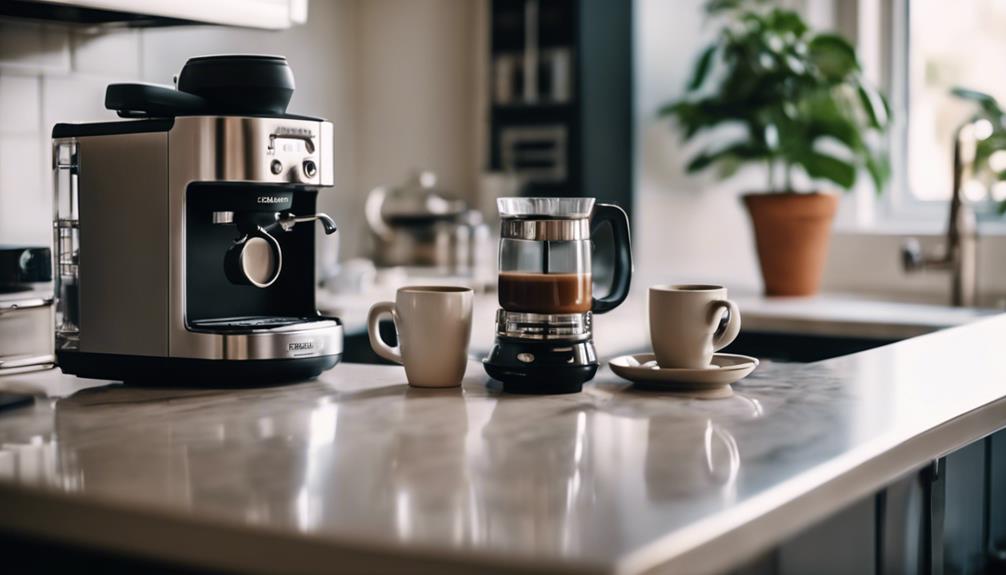
You're now the barista, bringing the coffee shop experience right into your own kitchen with the Breville Bambino's versatile capabilities.
With this machine, you can create a variety of coffee drinks that cater to your unique tastes. Whether you prefer a strong single shot or a rich double shot, the Breville Bambino has got you covered. You can use freshly ground coffee beans to make each shot, ensuring the best flavor possible.
The machine's quick setup and activation time of just three seconds mean you can enjoy your coffee without waiting around. Plus, with control over milk froth levels and temperature settings, you can customize your beverages to suit your taste.
Want a latte or cappuccino? No problem! The Breville Bambino makes it easy to create these popular coffee drinks at home. By using freshly frothed milk and expertly pulled shots, you'll be able to elevate your home coffee experience to new heights.
With the Breville Bambino, you'll be enjoying coffee shop-quality drinks in the comfort of your own home in no time.
Frequently Asked Questions
How to Make a Latte at Home With Breville Espresso Machine?
You're just a few steps away from a perfect latte! Start by brewing a double shot of espresso, then froth milk to your desired level using the steam wand, and combine for a beautiful layered effect.
Why Is Breville so Expensive?
You're likely wondering why Breville is pricey. It's due to the brand's focus on quality materials, innovative technology, and user-friendly features, which justify the higher cost for a premium coffee experience and long-term durability.
What Is the Best Grind Number for Breville Espresso?
You're seeking the perfect grind, balancing flavor and crema. Typically, a setting between 14 and 18 is ideal. You'll want to experiment, adjusting in small increments, to find your perfect shot, as you refine your espresso game.
Can You Put Ground Coffee in a Breville Espresso Machine Grinder?
You can't put ground coffee directly into the Breville Bambino's components, as it doesn't have a built-in grinder. Instead, you'll need to use a separate grinder to prepare the coffee before loading it into the machine.
Conclusion
You're now the maestro of your own coffee universe, with the Breville espresso maker as your trusted sidekick.
Just as a skilled artist weaves a masterpiece, you'll craft rich, velvety shots that awaken your senses.
As the aromatic espresso flows, imagine the morning sun bursting through your window, bathing your day in warmth and possibility.
Your coffee game has officially been elevated, and every sip is a reflection of your newfound mastery.
Espresso
What Is Espresso? Uncover the Secrets Behind This Bold Brew!
Behind the rich flavors and aromas of espresso lies a world of history, technique, and precision – discover its secrets.

You're about to discover the rich world of espresso, where a perfect blend of coffee beans, precise brewing techniques, and a dash of history come together to create a bold and complex brew. Espresso originated in 19th-century Italy, where innovators like Angelo Moriodo and Luigi Bezzera pioneered steam-driven coffee machines. To craft the perfect shot, you'll need high-quality beans, a balanced roast profile, and a fine grind size. With the right techniques and equipment, you can reveal the secrets of espresso and experience the vibrant flavors and aromas that make it a beloved morning ritual – and that's just the beginning.
Key Takeaways
- Espresso originated in 19th-century Italy, driven by increased coffee demand and the need for faster preparation.
- High-quality coffee beans, freshly roasted, yield rich flavor and aroma, with balanced roast profiles avoiding overly intense light roasts.
- The perfect brewing process involves optimal machine condition, fine grind size, consistent pressure, and peak extraction time of 25-30 seconds.
- Espresso brewing techniques require even tamping, ideal grind size, and proper extraction times for balanced flavor and improved extraction.
Origins of Espresso
When you explore the rich history of espresso, you'll find that it originated in 19th-century Italy as a response to the growing coffee demand and the need for faster coffee preparation in cafes. As coffee became an integral part of Italian culture, the need for a quicker brewing method became apparent.
Angelo Moriodo's invention of the first steam-driven coffee machine in 1884 marked the beginning of espresso's evolution. Luigi Bezzera improved upon Moriodo's design, using steam pressure to brew coffee, which laid the groundwork for modern espresso machines.
The term 'espresso' is derived from the Italian verb 'esprimere,' meaning 'to press out,' reflecting the method of extracting coffee rather than the speed of preparation. You might think that 'espresso' refers to the speed at which coffee is made, but it's actually about the process of forcing pressurized hot water through finely ground coffee.
Understanding the origins of espresso and its early innovators, like Moriodo and Bezzera, helps you appreciate the complexity of brewing coffee and the significance of Italy in shaping the world's coffee culture.
Delving into espresso's history can also help you refine your coffee palate and appreciation for the perfect cup.
The Perfect Brewing Process
To master the art of brewing espresso, you'll need to focus on several key elements that work together to create the perfect shot.
First, verify your espresso machine is in top condition, as it's the foundation of the brewing process.
Next, pay attention to the grind size of your coffee beans – a fine grind, similar to table salt, is ideal for even extraction and peak flavor.
When loading the portafilter, use 18-20 grams of coffee grounds for a single shot, which will result in a rich and concentrated brew.
Tamp the grounds with consistent pressure to promote balanced extraction and flavor.
Now, it's time to brew. The peak extraction time is between 25-30 seconds – too fast and the flavors will be weak, too slow and the shot will be bitter.
As you perfect the brewing process, you'll reveal the rich flavors that espresso has to offer.
With practice, you'll be able to coax out the unique characteristics of each coffee bean, creating a truly exceptional shot.
Ideal Coffee Bean Selection
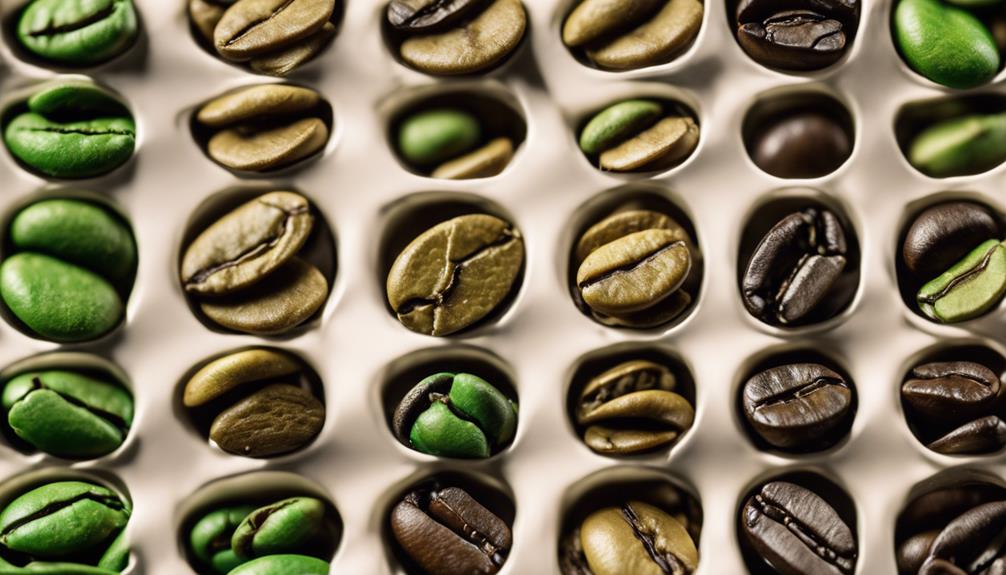
Selecting the right coffee beans is crucial for crafting exceptional espresso, and you'll want to focus on high-quality, freshly roasted beans that offer unique flavor profiles. When choosing beans, consider the roast profile and flavor profile you prefer. Here's a breakdown of key considerations:
| Bean Characteristics | Impact on Espresso |
|---|---|
| High-quality beans | Rich, vibrant flavor and aroma |
| Freshly roasted beans | Ideal flavor and aroma, with notes of fruit and chocolate |
| Balanced roast profile | Avoids overly intense light roasts, yielding a smooth, full-bodied espresso |
When selecting beans, you'll want to avoid those that are too light or too dark. Instead, opt for beans with a balanced roast profile that will yield a smooth, full-bodied espresso. High-quality beans are crucial for ideal flavor, and freshly roasted beans will guarantee the best possible taste. By choosing the right beans, you'll be well on your way to crafting exceptional espresso. Remember, the quality of the beans greatly influences espresso craftsmanship, so don't be afraid to experiment with different roast profiles and flavor profiles to find your perfect cup.
Espresso Roast Profile Explained
Now that you've selected the perfect coffee beans, it's time to explore the art of espresso roast profiles.
You'll want to understand the characteristics of espresso roasts, which are typically darker and roasted longer to bring out rich and bold flavors.
Espresso Roast Characteristics
When it comes to crafting the perfect espresso shot, understanding the nuances of espresso roast characteristics is key, as the roast profile plays a significant role in bringing out the desired flavors and aromas in your cup.
As you experiment with different espresso roast profiles, you'll discover that they often showcase a deeper, more caramelized flavor profile, thanks to the extended roasting time. However, keep in mind that achieving the perfect balance requires selecting the right type of coffee beans and fine-tuning your roast levels.
It's widely recognized that certain espresso beans – like lighter roasts – can yield overly intense flavors when brewed as espresso, resulting in a cup that's unbalanced and possibly bitter. Conversely, combining different coffee bean origins in the perfect proportion creates the magic blend you want.
That balance directly hinges on both beans you have to craft to effectively keep pace or resonate sound frequency. Yet, combining sound process procedures and putting the correct quantity can yield outstanding pure notes. This set blending produces the peak experience in your espresso.
Flavor Profile Balance
You're likely familiar with the concept that achieving a perfect balance in flavor profiles is vital for a great espresso experience, as it hinges on the delicate interplay between sweetness, acidity, and bitterness.
When it comes to espresso roast profiles, finding this balance is vital. Lighter roasts can be too intense if not roasted carefully, while darker roasts may become bitter if over-roasted. Adjusting roasting times and temperatures helps achieve the desired flavor balance, allowing for variations that cater to personal taste preferences.
To create a balanced espresso, roasters often blend different coffee grounds, including robusta beans, to enhance the caffeine content and introduce a fuller body. The ideal espresso roast profile should result in a harmonious combination of sweetness, acidity, and bitterness.
The presence of crema is a key indicator of the espresso's quality and flavor balance. By understanding how to balance flavor profiles, you'll be able to appreciate the nuances of different espresso roast profiles and find the perfect blend to suit your taste.
Whether you prefer a brighter, more acidic flavor or a richer, more robust taste, achieving flavor balance is vital for a great espresso experience.
Brewing Techniques and Tips
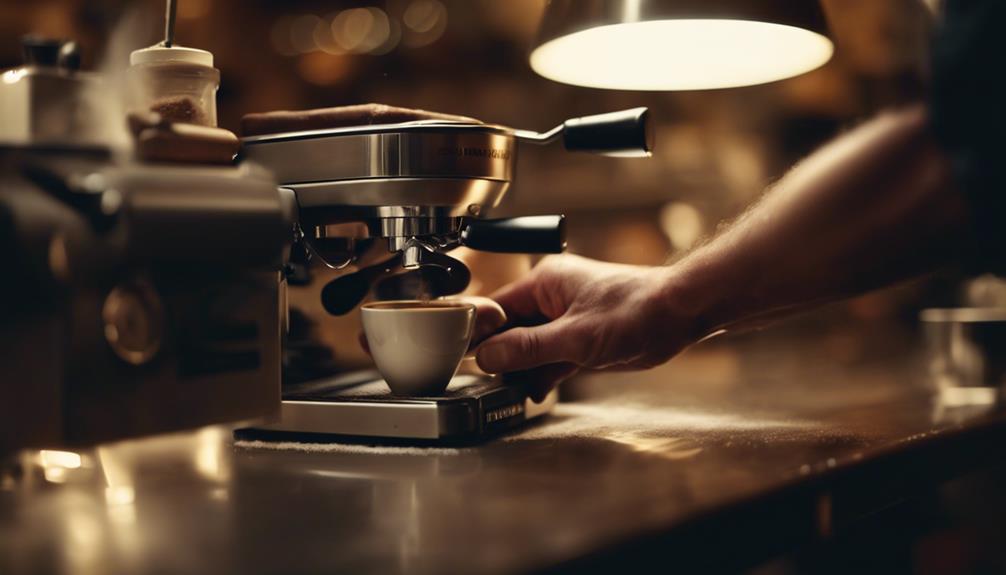
As you explore the world of espresso brewing, you'll quickly realize that perfecting the grind size is essential for achieving that perfect shot.
Mastering the grind size requires attention to detail and a bit of experimentation to find the ideal consistency.
Perfecting the Grind Size
To perfect the grind size for espresso, it's crucial to aim for a fine grind, similar to table salt, which is necessary for ideal extraction and rich flavor.
As you work to master the grind size, consider these key factors to optimize your brewing experience:
- Uniformity is key, and a burr grinder can help achieve the consistency needed for even extraction.
- A fine grind can enhance extraction but can also lead to bitterness if over-extracted.
- For a single shot of espresso, the ideal dose is between 18-20 grams of ground coffee, making precise measurements in grinding essential.
- Experimenting with different grind sizes affects the flavor profile; adjusting this is part of fine-tuning the espresso shot.
Keep these aspects in mind, and remember, fine-tuning your grind size with each use can guarantee your ground coffee complements your burr grinder for an unparalleled shot of espresso every time.
With consistent experimentation, you can enjoy that bold flavor everyone wants to know more about – every shot will deliver perfect and engaging outcomes in mastering that strong blend in brew form!
Mastering Brewing Techniques
Mastering brewing techniques is crucial for releasing the full flavor potential of your espresso, and it starts with understanding the importance of even tamping and precise water temperature control. When you tamp the coffee grounds evenly, you guarantee a balanced flavor profile and improved extraction quality. Additionally, monitoring the water temperature between 195-205°F during brewing is imperative, as this range greatly impacts the final taste of the espresso.
To achieve the perfect coffee, consider the following brewing techniques:
| Brewing Method | Water Temperature | Coffee-to-Water Ratio |
|---|---|---|
| Espresso | 195-205°F | 1:2 |
| Pour-over | 200-210°F | 1:15 |
| French press | 195-205°F | 1:12 |
When brewing espresso, use 18-20 grams of coffee grounds in the portafilter and aim for an extraction time of 25-30 seconds. This will prevent weak flavors from fast extractions or bitterness from slow extractions. By mastering these brewing techniques, you'll be able to bring out the unique flavors of your favorite beans and enjoy a perfect cup of coffee every time. With practice and patience, you'll become a skilled barista, capable of crafting exceptional espresso shots that impress even the most discerning coffee connoisseurs.
Fun Facts and Trivia
Discovering the lesser-known facts behind your favorite morning shot of espresso reveals a complex beverage that's full of surprising details, ranging from its etymology to brewing methods and misconceptions surrounding it.
As you sip on your espresso, you might be wondering what makes it so unique. Let's explore some fun facts and trivia that'll make you appreciate your daily cup even more.
Here are a few interesting tidbits about espresso:
- Espresso doesn't actually mean 'express' in Italian, but rather 'to press out' from the verb 'esprimere'.
- You might think espresso has more caffeine than filter coffee, but a standard serving of espresso actually contains less caffeine overall.
- Italian regulations require specific criteria for a shot of espresso to be considered true espresso, including minimum brewing pressure and extraction time.
- Historically, espresso blends often included robusta beans to increase caffeine content and enhance crema.
These facts show that there's more to espresso than just its bold flavors and rich aromas.
Whether you're a coffee connoisseur or just a casual fan, understanding the intricacies of espresso can enhance your appreciation for this beloved beverage.
Frequently Asked Questions
What Scientists Claim to Have Discovered the Secret to Perfect Espresso?
You're about to uncover the secret to perfect espresso! Scientists claim to have discovered that adding water before grinding coffee beans enhances consistency and taste, reducing static electricity and waste, and leading to stronger flavor extraction.
What Is Bold Espresso?
"Variety is the spice of life," and when it comes to bold espresso, you're in for a treat. You're brewing a concentrated coffee by forcing hot water through finely ground beans, resulting in a rich, strong flavor.
How Is Espresso Different From Coffee?
You're probably wondering how espresso differs from regular coffee. The main differences lie in brewing pressure, grind size, extraction time, and serving size, resulting in a richer, more intense flavor and a unique crema layer in espresso.
What Is the Difference Between Bold and Strong Coffee?
You might've noticed how some friends order "bold" coffee, while others ask for "strong" coffee. What's the difference? Think of it like music – bold coffee is like a rich, complex symphony, while strong coffee is more like a loud, intense beat.
Conclusion
As you wrap up your espresso journey, it's no coincidence that you've discovered the perfect blend of art and science.
The rich flavors and bold aromas have likely left you wondering how something so small can pack such a punch.
It's a coincidence that the same passion and dedication that goes into crafting each shot is the same passion that drives you to savor every last drop.
Espresso
How to Make the Perfect Espresso Martini – Step-by-Step Guide!
Learn the art of crafting the ultimate Espresso Martini with our expert guide, but be warned: once you taste perfection, there's no turning back.

To make the perfect Espresso Martini, you'll need 50ml of vodka, 35ml of coffee liqueur, and 25ml of freshly brewed espresso. Start by brewing a strong shot of espresso and letting it cool. Fill a cocktail shaker with ice, add the vodka, coffee liqueur, and a splash of simple syrup, and shake vigorously for 15 seconds. Double strain the mixture into a chilled martini glass and garnish with three coffee beans. With these basics down, you're ready to take your Espresso Martini to the next level – and with a few tweaks, you can make it truly unforgettable.
Key Takeaways
- Brew a strong shot of espresso and let it cool to maintain flavor in the martini.
- Fill a cocktail shaker with ice, adding vodka, coffee liqueur, and simple syrup for a balanced mix.
- Shake the mixture vigorously for 15 seconds to create a rich, frothy texture in the martini.
- Double strain the mixture into a chilled martini glass using a cocktail strainer and fine mesh sieve.
Ingredients and Equipment Needed
To craft the perfect Espresso Martini, you'll need to gather a few essential ingredients and pieces of equipment, starting with a trifecta of vodka, coffee liqueur, and freshly brewed espresso.
The vodka should be 50ml, while the coffee liqueur should be 35ml – Kahlúa is a popular choice. The espresso, which is the star of the show, should be 25ml and freshly brewed.
In terms of equipment, you'll need a cocktail shaker to mix everything together. A jigger will also come in handy for accurate measurement of the ingredients.
Additionally, a fine mesh sieve or cocktail strainer is necessary for a smooth pour into the martini glass. Don't forget the ice – you'll need fresh cubes to chill the cocktail without diluting it.
A pre-chilled martini glass is also a must, so make sure to fill it with ice before pouring in the Espresso Martini.
With these ingredients and equipment at your disposal, you'll be well on your way to creating the perfect Espresso Martini.
Step-by-Step Preparation Guide
With your ingredients and equipment at the ready, it's time to start crafting the perfect Espresso Martini by following a simple, step-by-step preparation guide.
Begin by brewing a strong shot of espresso and letting it cool to prevent dilution when mixed with ice.
Next, fill a cocktail shaker with ice, then add 1 1/2 oz. vodka, 1 oz. coffee liqueur (like Kahlúa), and 1/2 oz. simple syrup to balance the flavors.
Shake the mixture vigorously for about 15 seconds to create a frothy texture and guarantee everything is well combined. This step is essential in bringing out the rich flavors of the espresso and coffee liqueur.
After shaking, double strain the mixture into a chilled martini glass to achieve a smooth pour and eliminate any ice shards.
Finally, garnish with three coffee beans to symbolize health, wealth, and happiness, and serve immediately for the best experience.
Expert Tips for Success
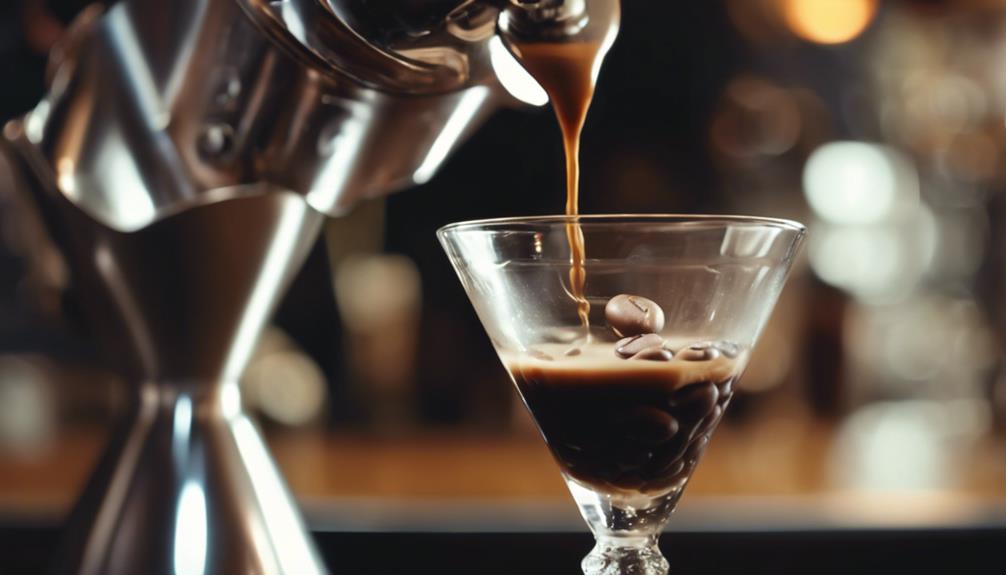
Mastering the art of crafting the perfect Espresso Martini requires attention to detail and a few expert tips to elevate your mixology skills.
To start, verify your espresso is freshly brewed and cooled to prevent dilution when mixed with ice in the cocktail shaker. This simple step will make a significant difference in the overall flavor and texture of your Espresso Martini.
When shaking the mixture, don't be shy – vigorously shake the cocktail shaker for at least 15 seconds to create a rich, frothy texture that enhances the drink's presentation and mouthfeel.
To achieve a smooth pour without ice shards, use a cocktail strainer along with a fine mesh sieve to double strain the mixture.
Experiment with different coffee liqueurs, such as Tia Maria or newer brands, to discover unique flavor profiles that suit your taste preferences.
Finally, adjust the amount of simple syrup to balance the bitterness of the espresso with the sweetness of the liqueur.
By following these expert tips, you'll be well on your way to crafting a perfect Espresso Martini that will impress even the most discerning palates.
With practice, you'll refine your skills and create a truly exceptional cocktail.
Understanding the Espresso Martini
You're about to explore the world of the Espresso Martini, a cocktail that's equal parts energizing and indulgent, and has been a staple of nightlife for decades. This classic drink has gained a massive following among coffee lovers and cocktail enthusiasts alike.
The Espresso Martini's unique blend of vodka, coffee liqueur, and freshly brewed espresso creates a flavor profile that's both rich and indulgent. The drink's origins date back to the 1980s, when British bartender Dick Bradsell created it in response to a request for a drink that would both awaken and intoxicate the drinker.
Traditionally garnished with three coffee beans, each bean symbolizes health, wealth, and happiness in Italian culture. The Espresso Martini's popularity soared in London's nightlife and has seen a resurgence in recent years. Its balance of bitter espresso and sweet coffee liqueur makes it a perfect choice for after dinner or special occasions.
As you explore into the world of the Espresso Martini, you'll discover why it's a timeless classic that continues to captivate palates around the world. With its unique flavor profile and energizing kick, it's no wonder the Espresso Martini remains a favorite among coffee lovers and cocktail enthusiasts.
Common Variations and Substitutions
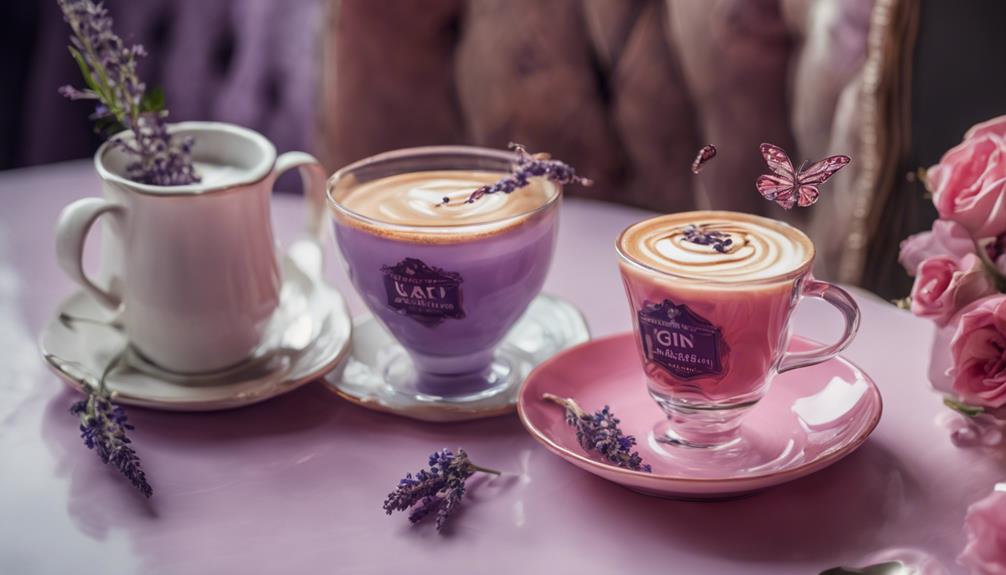
When it comes to perfecting the Espresso Martini, the door is wide open to creativity through substitutions and variations, allowing you to customize this iconic cocktail to suit your personal taste.
If you don't have an espresso machine, you can try using cold brew concentrate as a substitute for espresso, which provides a similar coffee flavor without the need for brewing.
In addition to espresso substitutes, you can also experiment with coffee liqueur alternatives to Kahlúa. Try using Tia Maria or a newer brand to offer a unique flavor profile to your martini.
If you're looking to make sweetness adjustments, you can modify or omit the simple syrup altogether. If you prefer a less sweet drink, consider reducing the amount or using flavored syrups like vanilla or hazelnut.
Serving Suggestions and Pairings
What makes the Espresso Martini truly shine is its versatility in pairing with a variety of sweet and savory treats, allowing you to elevate your entertaining game with ease. When it comes to pairings, you can't go wrong with rich desserts like chocolate mousse or tiramisu, which complement the drink's coffee notes perfectly. But that's not all – the Espresso Martini also makes a delightful after-dinner drink, helping to alleviate post-meal lethargy with its caffeine content.
| Occasion | Pairing Suggestions | Why it Works |
|---|---|---|
| Dinner Party | Dark chocolate or gourmet coffee-flavored treats | Elevates the tasting experience with sophisticated flavors |
| Birthday or New Year's Eve | Light appetizers like cheese platters or charcuterie boards | Balances savory and sweet elements for a festive atmosphere |
| After Dinner | Rich desserts like chocolate mousse or tiramisu | Complements the drink's coffee notes and alleviates post-meal lethargy |
| Casual Gathering | Coffee-flavored cookies or brownies | Enhances the drink's rich coffee flavor and adds a playful touch |
Frequently Asked Questions
What Are the Ingredients of an Espresso Martini?
You're looking for the ingredients of an Espresso Martini! Typically, you'll need 50ml of vodka, 35ml of coffee liqueur, and 1 shot of freshly brewed espresso, with optional simple syrup and Baileys for added flavor.
What Is the 3 Bean Rule for Espresso Martini?
You're about to discover the 3 bean rule, a traditional garnish for Espresso Martinis, symbolizing health, wealth, and happiness. This iconic presentation involves three coffee beans, typically arranged in a triangle pattern, on top of your drink.
What Are the Standards in an Espresso Martini?
"As you begin crafting an espresso martini, recall: "don't just aim to get close to perfect; instead aim beyond the possibility of 'very close.' Shoot to ace every corner on one precision push.'" Then define the actual definition without content contained context current webaddress–
What Liquor Is Best for an Espresso Martini?
When crafting an Espresso Martini, you'll want to choose a high-quality vodka that's smooth and flavorful. Opt for brands like Grey Goose or Belvedere, which won't overpower the other ingredients and will complement the coffee flavors nicely.
Conclusion
Now that you've mastered the art of crafting the perfect espresso martini, it's time to shake (not stir) things up!
With every sip, the rich flavors will transport you to a vibrant Italian night, where the air is electric and the music is pulsating.
Your taste buds will do the tango with the bold espresso, velvety vodka, and sweet coffee liqueur.
Cheers to a drink that's sure to perk up any gathering!
-

 Coffee Guides2 weeks ago
Coffee Guides2 weeks agoBoost Your Coffee: Easy Ways to Enhance Your Brew
-

 Coffee Guides2 weeks ago
Coffee Guides2 weeks agoBrew Perfect Coffee at Home: Expert Tips & Tricks
-

 Health and Wellness2 weeks ago
Health and Wellness2 weeks agoHeadache-Free: How to Avoid Coffee Headaches!
-

 Vetted2 weeks ago
Vetted2 weeks ago15 Best Trundle Beds for Maximizing Space and Style in Your Home
-

 Coffee Guides2 weeks ago
Coffee Guides2 weeks agoBecome a Coffee Master: Expert Brewing Tips
-

 Coffee Guides2 weeks ago
Coffee Guides2 weeks agoBreve Coffee Explained: Your Cozy Café Favorite
-

 Coffee Guides2 weeks ago
Coffee Guides2 weeks agoHow to Be a Coffee Cup: Embrace Your Inner Brew
-

 Vetted2 weeks ago
Vetted2 weeks ago15 Best Cordless Pool Vacuums for Effortless Pool Cleaning
















